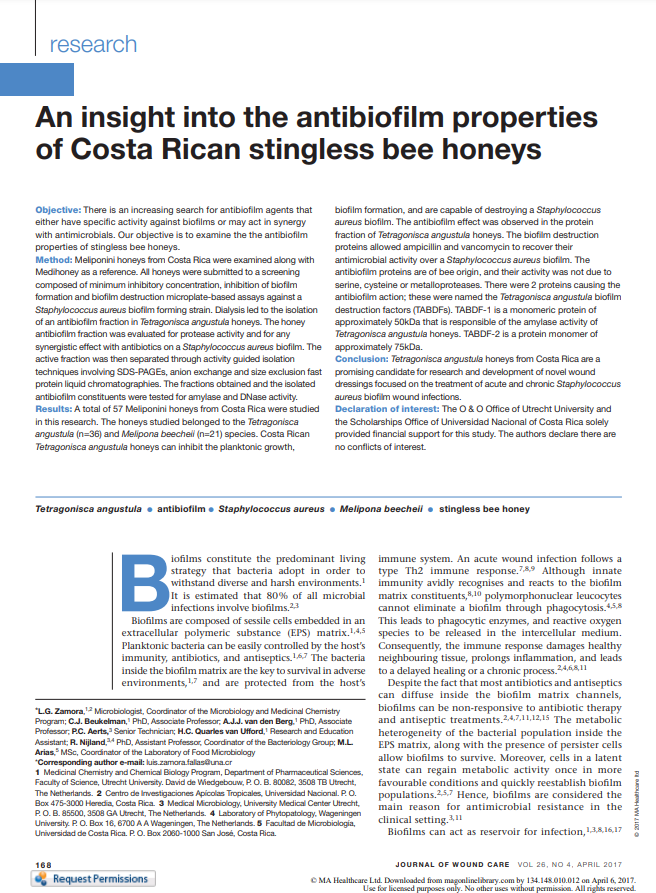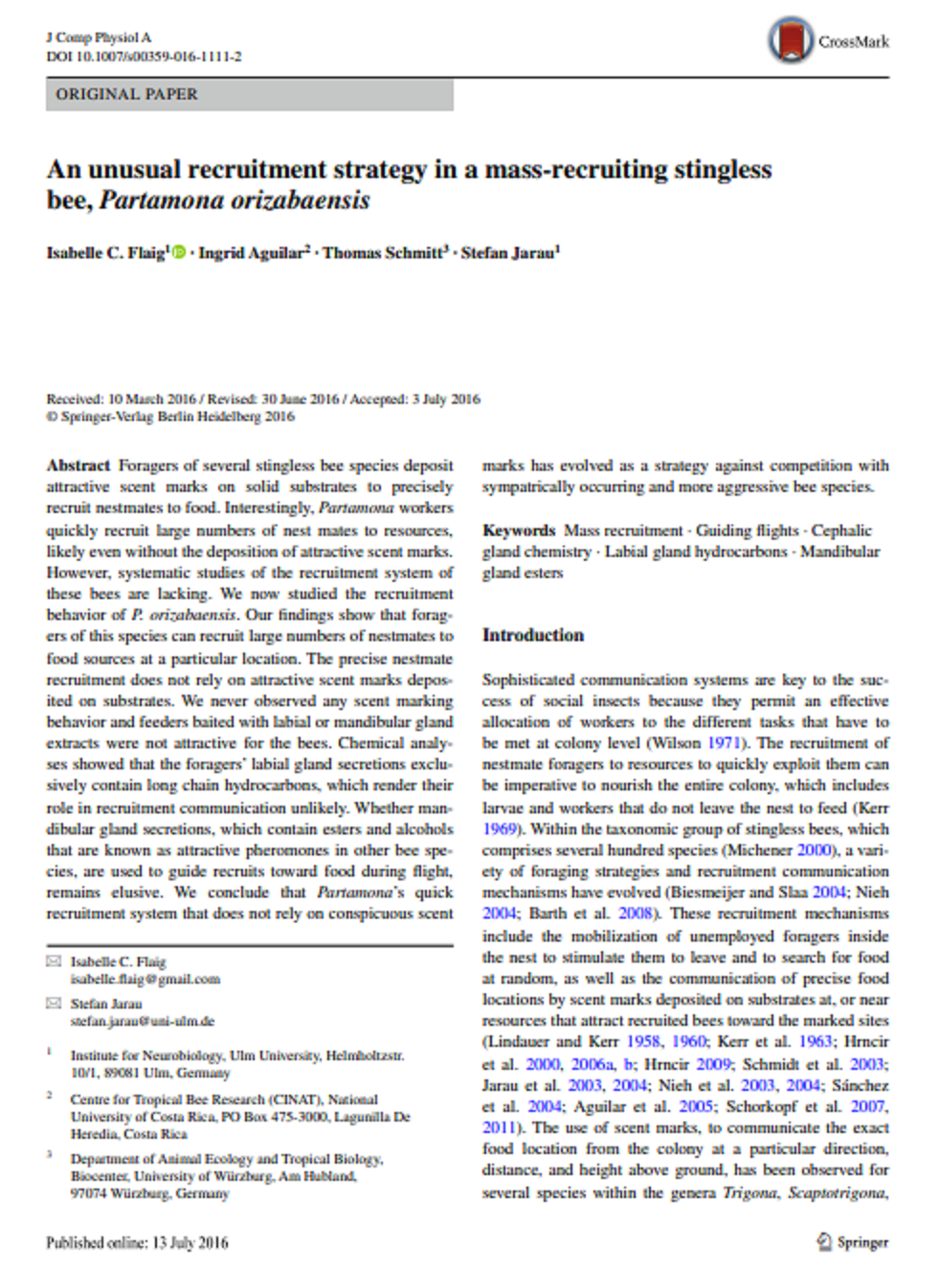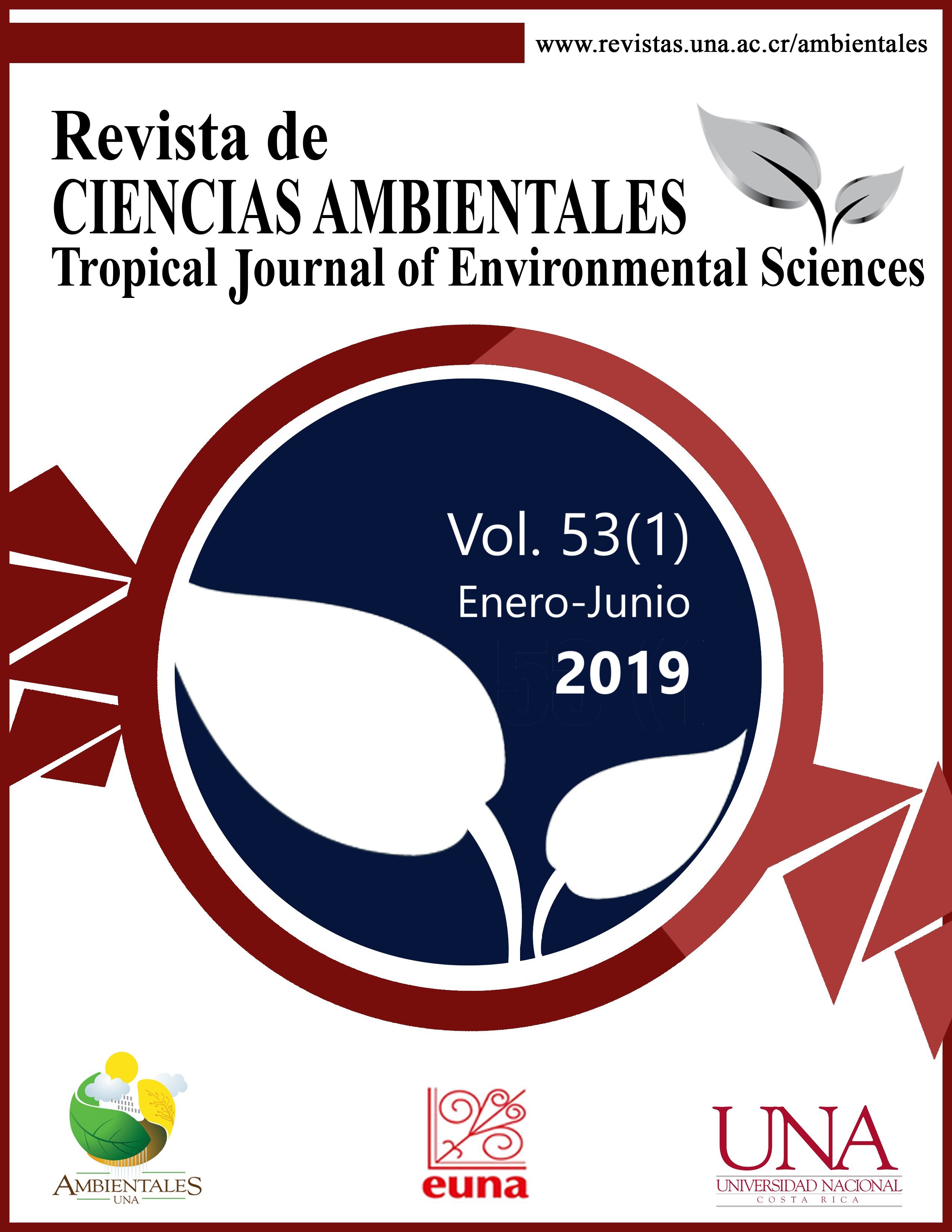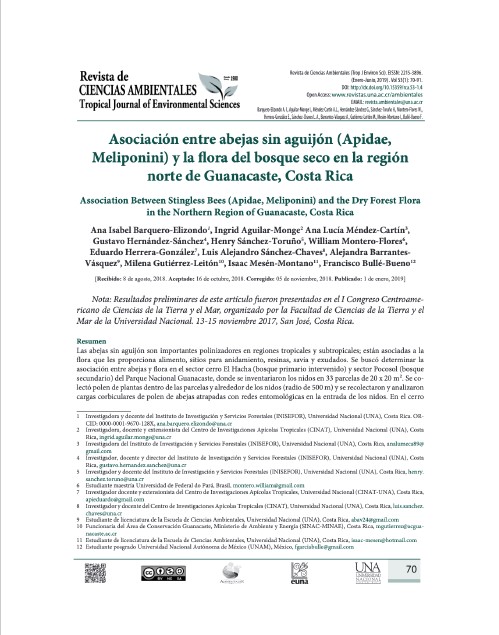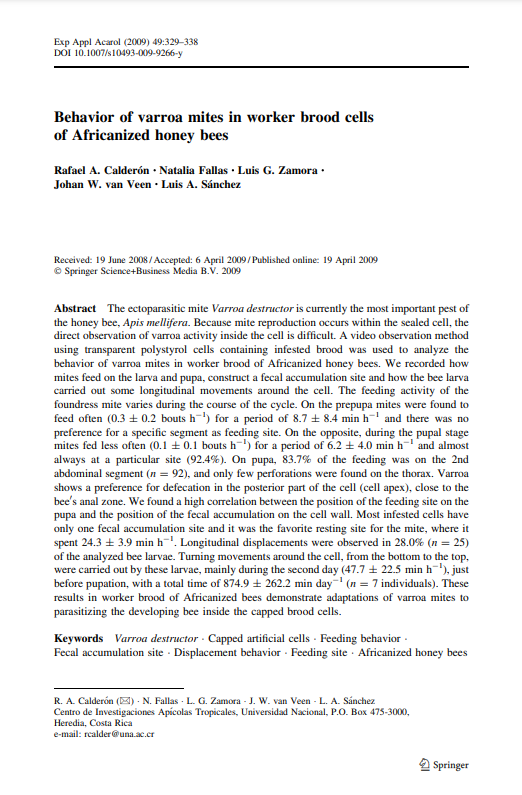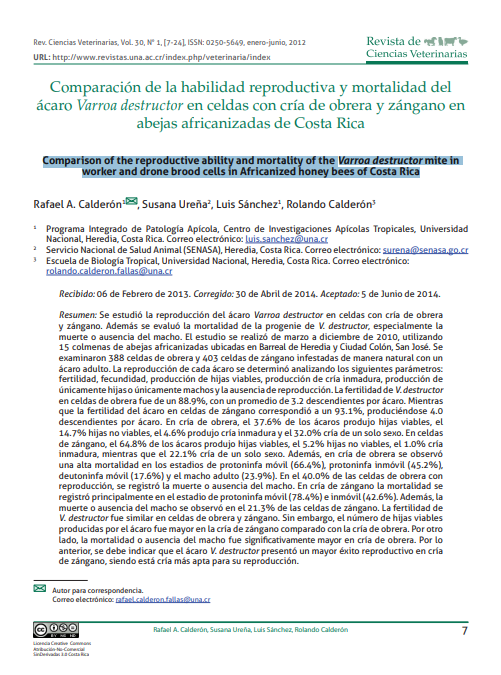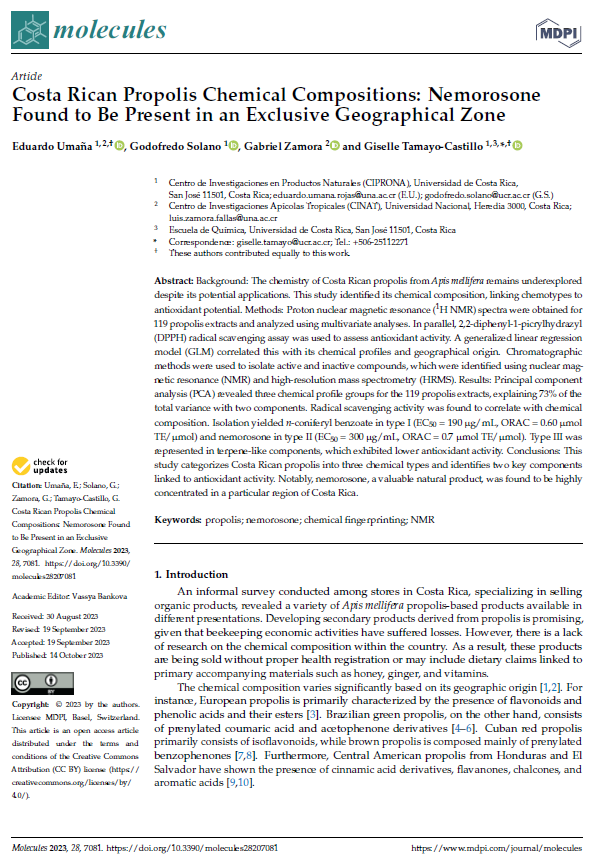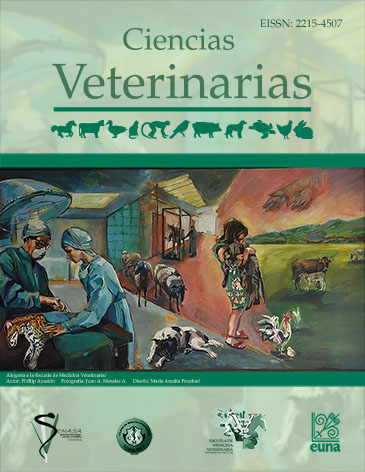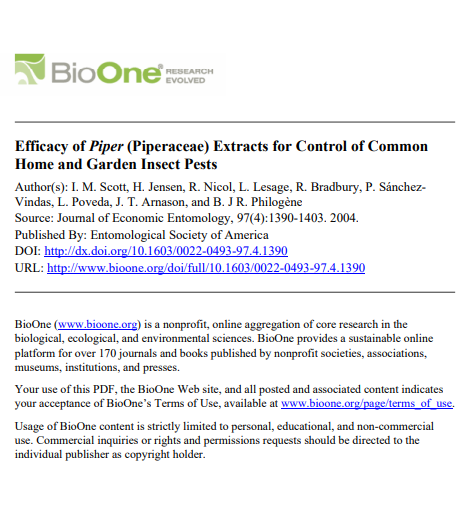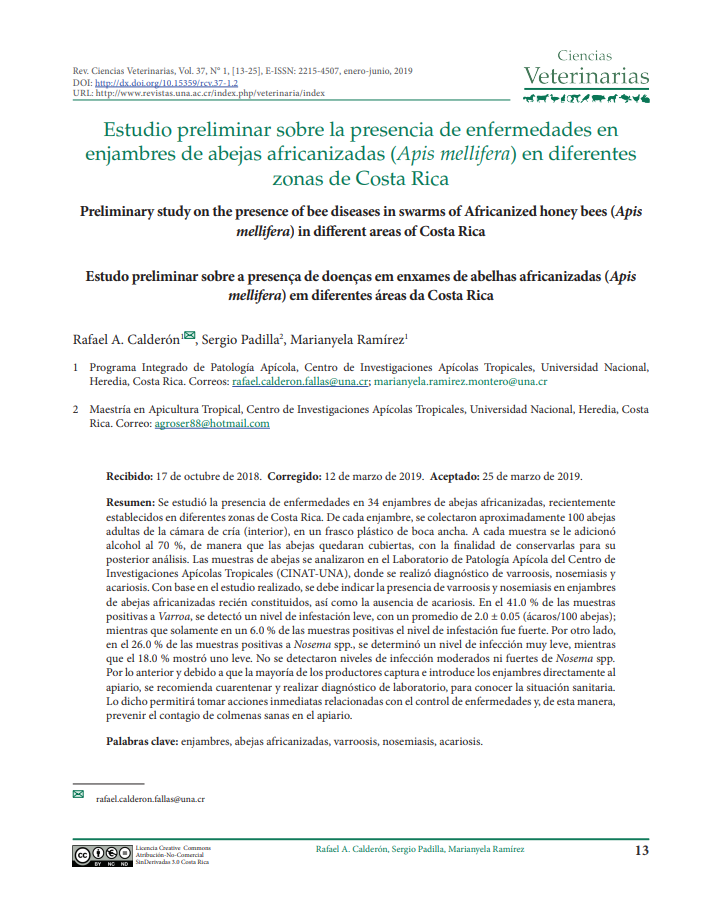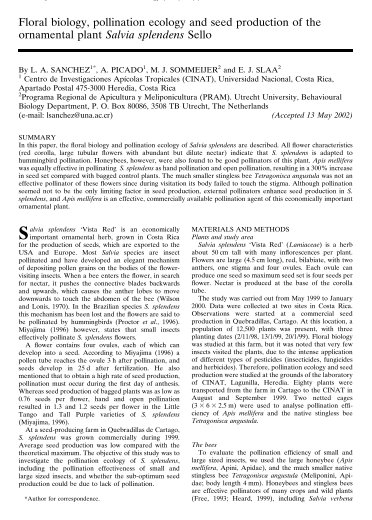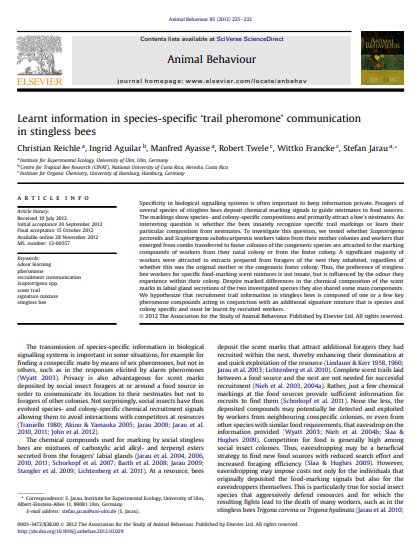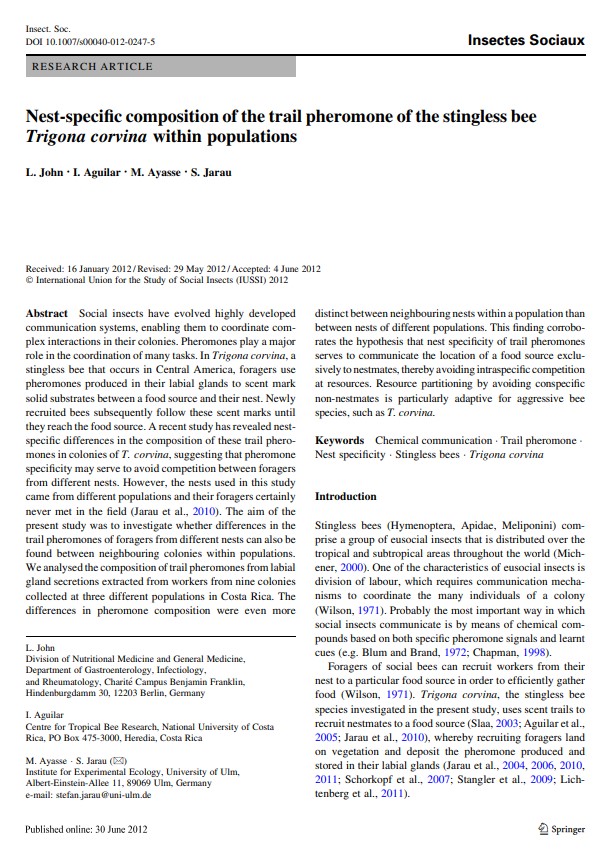Browsing Artículos Científicos by Title
Now showing items 1-20 of 39
-
Actual situation of Aethina tumida (Coleoptera: Nitidulidae) in Africanized honeybee colonies in Costa Rica
(2019)In the present study, the presence of the beetle Aethina tumida in Central American countries such as El Salvador, Nicaragua and Costa Rica is analyzed by visual sampling in which all individual frames, hive covers and ... -
An insight into the antibiofilm properties of Costa Rican stingless bee honeys
(Journal of Wound Care, 2017-04-05)Our objective is to examine the the antibiofilm properties of stingless bee honeys. Meliponini honeys from Costa Rica were examined along with Medihoney as a reference. All honeys were submitted to a screening composed of ... -
An unusual recruitment strategy in a mass-recruiting stingless bee, Partamona orizabaensis
(Springer-Verlag Berlin Heidelberg, 2016-07-13)Foragers of several stingless bee species deposit attractive scent marks on solid substrates to precisely recruit nestmates to food. Interestingly, Partamona workers quickly recruit large numbers of nest mates to resources, ... -
Asociación entre abejas sin aguijón (Apidae, Meliponini) y la flora del bosque seco en la región norte de Guanacaste, Costa Rica
(Universidad Nacional, Costa Rica, 2019-01-01)Las abejas sin aguijón son importantes polinizadores en regiones tropicales y subtropicales; están asociadas a la flora que les proporciona alimento, sitios para anidamiento, resinas, savia y exudados. Se buscó determinar ... -
Asociación entre abejas sin aguijón (Apidae, Meliponini) y la flora del bosque seco en la región norte de Guanacaste, Costa Rica
(Revista De Ciencias Ambientales, UNA, 2018-11-12)Las abejas sin aguijón son importantes polinizadores en regiones tropicales y subtropicales; están asociadas a la flora que les proporciona alimento, sitios para anidamiento, resinas, savia y exudados. Se buscó determinar ... -
Baltimora recta: a pollen and nectar plant for honey bees during dearth periods in Costa Rica
(Bee Worl, 2001-01-01)Baltimora recta: a pollen and nectar plant for honey bees during dearth periods in Costa Rica. In the rainy season, during the short dry period that divides it, an extensive and dominant bloom of this herb is found ... -
Behavior of varroa mites in worker brood cells of Africanized honey bees
(Experimental and Applied Acarology/ Springer, 2019-04-19)El ácaro ectoparásito Varroa destructor es actualmente la plaga más importante de la abeja melífera, Apis mellifera. Dado que la reproducción del ácaro tiene lugar dentro de la celda sellada, la observación directa de la ... -
Comparación de la habilidad reproductiva y mortalidad del ácaro Varroa destructor en celdas con cría de obrera y zángano en abejas africanizadas de Costa Rica
(Universidad Nacional, Costa Rica, 2014-10-31)Se estudió la reproducción del ácaro Varroa destructor en celdas con cría de obrera y zángano. Además se evaluó la mortalidad de la progenie de V. destructor, especialmente la muerte o ausencia del macho. El estudio se ... -
Costa Rican propolis chemical compositions: nemorosone found to be present in an exclusive geographical zone
(MDPI, 2023-10-14)The chemistry of Costa Rican propolis from Apis mellifera remains underexplored despite its potential applications. This study identified its chemical composition, linking chemotypes to antioxidant potential. Methods: ... -
Diagnóstico automático de infección por Nosemiasis en abejas melíferas mediante procesado de imágenes
(Instituto Tecnológico de Costa Rica, 2018)Las abejas polinizan una gran variedad de especies de plantas, incluyendo los cultivos agrícolas. Se estima que cerca del 30% del alimento consumido por la población mundial es derivado de cultivos polinizados por abejas. ... -
Distribución del Pequeño Escarabajo de la Colmena, Aethina tumida, en abejas africanizadas (Apis mellifera) en diferentes zonas apícolas de Costa Rica
(Universidad Nacional, Costa Rica, 2020)El primer reporte sobre la presencia del Pequeño Escarabajo de la Colmena (PEC), Aethina tumida, en Costa Rica, se realizó el 25 de agosto 2015, en La Cruz, Guanacaste; lo cual aumenta el riesgo de dispersión a otras ... -
Distribución del Pequeño Escarabajo de la Colmena, Aethina tumida, en abejas africanizadas (Apis mellifera) en diferentes zonas apícolas de Costa Rica
(Universidad Nacional, Costa Rica, 2020-07-01)El primer reporte sobre la presencia del Pequeño Escarabajo de la Colmena (PEC), Aethina tumida, en Costa Rica, se realizó el 25 de agosto 2015, en La Cruz, Guanacaste; lo cual aumenta el riesgo de dispersión a otras zonas ... -
Efficacy of Piper (Piperaceae) extracts for control of common home and garden insect pests
(Entomological Society of America, 2004)Extracts from three species of the plant family Piperaceae, Piper nigrum [L.], Piper guineense [Schum & Thonn], and Piper tuberculatum [Jacq.], were tested for efficacy against insects from five orders. All three species ... -
Estudio preliminar sobre la presencia de enfermedades en enjambres de abejas africanizadas (Apis mellifera) en diferentes zonas de Costa Rica.
(Universidad Nacional, Costa Rica, 2019)Se estudió la presencia de enfermedades en 34 enjambres de abejas africanizadas, recientemente establecidos en diferentes zonas de Costa Rica. De cada enjambre, se colectaron aproximadamente 100 abejas adultas de la ... -
Flora relevante para las abejas nativas sin aguijón en un sector del Parque Nacional Guanacaste
(Universidad Nacional, Costa Rica, 2022)En esta obra se incluyen básicos descriptivos de las especies de plantas en flor, importantes para la nutrición y desarrollo se las poblaciones de abejas, presentes en las parcelas permanentes de monitoreo ubicadas en el ... -
Floral biology, pollination ecology and seed production of the ornamental plant Salvia splendens Sello
(Universidad Nacional, Costa Rica., 2002)In this paper, the floral biology and pollination ecology of Salvia splendens are described. All flower characteristics (red corolla, large tubular flowers with abundant but dilute nectar) indicate that S. splendens is ... -
Learnt information in species-specific ‘trail pheromone’ communication in stingless bees
(Elsevier, 2013)Specificity in biological signalling systems is often important to keep information private. Foragers of several species of stingless bees deposit chemical marking signals to guide nestmates to food sources. The markings ... -
Nest-specific composition of the trail pheromone of the stingless bee Trigona corvina within populations
(Springer, 2012)Social insects have evolved highly developed communication systems, enabling them to coordinate complex interactions in their colonies. Pheromones play a major role in the coordination of many tasks. In Trigona corvina, a ... -
New Record of the Small Hive Beetle, Aethina tumida, in Africanized Honey Bee Colonies in Costa Rica
(Bee World, 2019-02-27)The small hive beetle (SHB) Aethina tumida Murray (Insecta: Coleoptera: Nitidulidae) is a honey bee parasite native to sub-Saharan Africa (Hepburn & Radloff, 1998). It was first described by Murray in 1867. In 1996, SHBs ... -
Nosemosis in Africanized Honey Bee Colonies (Apis mellifera) in the Tropical Conditions of Costa Rica: Nosema apis or Nosema ceranae
(Universidad Nacional, Costa Rica, 2021)The presence of nosemosis in Africanized honey bees in Costa Rica was studied. A total of 75 samples of adult bees from different country regions were selected for molecular diagnosis of nosemosis. Prior to PCR tests, ...


